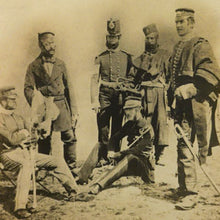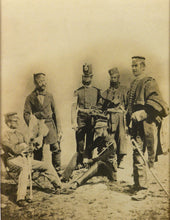The Buffs in the Crimea - Officer group by Roger Fenton, 1855
Adding product to your cart
Overall: 35cm (14.2in) x 30cm (12in)
Salt print. Roger Fenton group photograph of Brigadier General Van Straubenzee and Officers of The Buffs, 1855. Contained in modern mount and glazed frame.
The 3rd (East Kent) Regiment of Foot (or The Buffs) arrived in the Crimea in May 1855. It took part in the attack on the Quarries on 7 June and was also heavily involved in the second attack on the Redan on 8 September. Brigadier-General (later General Sir) Charles Thomas Van Straubenzee (1812-1892), seated in the middle wearing the regulation undress frock coat, initially commanded the so-called 'Separate Brigade' and later the 1st Brigade of the Light Division.
Read More
Roger Fenton (1819-1869), noted as one of the first war photographers, was a practising solicitor with an interest in painting, when he learned the art of photography around 1850. Within a short time he emerged as a well-known figure in the British photography scene, becoming the honorary secretary of the Royal Photographic Society, of which he was a founding member, and the first official photographer of the British Museum. The new medium of photography brought him into contact with technologically minded including influencers including Prince Albert and the Duke of Newcastle, Secretary of State for War, who urged Fenton to go to the Crimea to record events. The publisher Thomas Agnew & Sons commissioned Fenton to document the Crimean War, making first use of such on campaign. Using glass plate negatives and the wet collodion process, Fenton captured camp life, panoramas of battle scenes, and individual and group portraits of officers and soldiers. The negatives were then shipped back to Britain where they were used to make prints in two different ways – the salted paper print and the albumen print. The prints were later exhibited in London by Agnew in October 1855, with the first prints being offered for sale to the public the following month. Others were published at intervals over the next four to five months until all were available.








